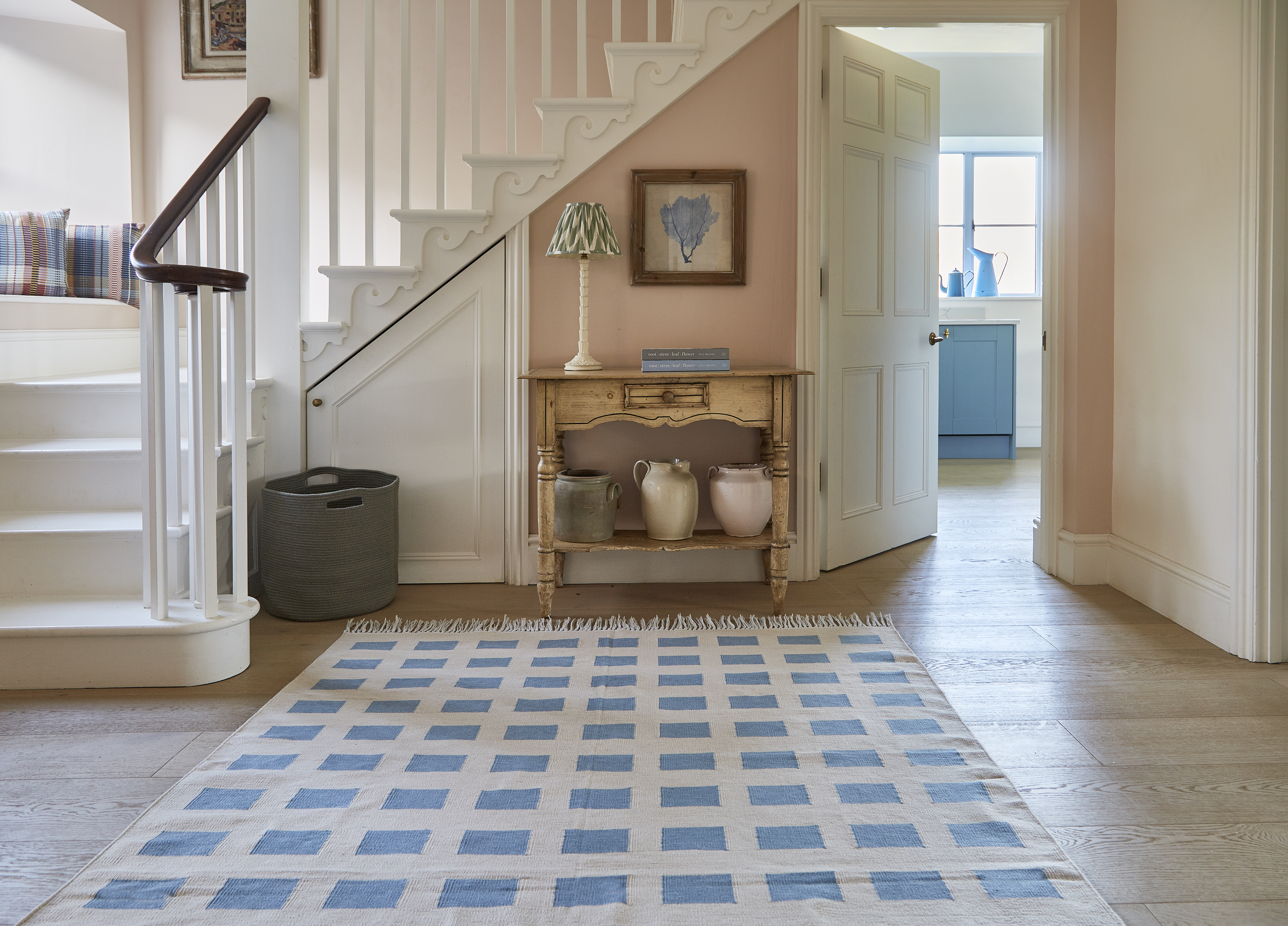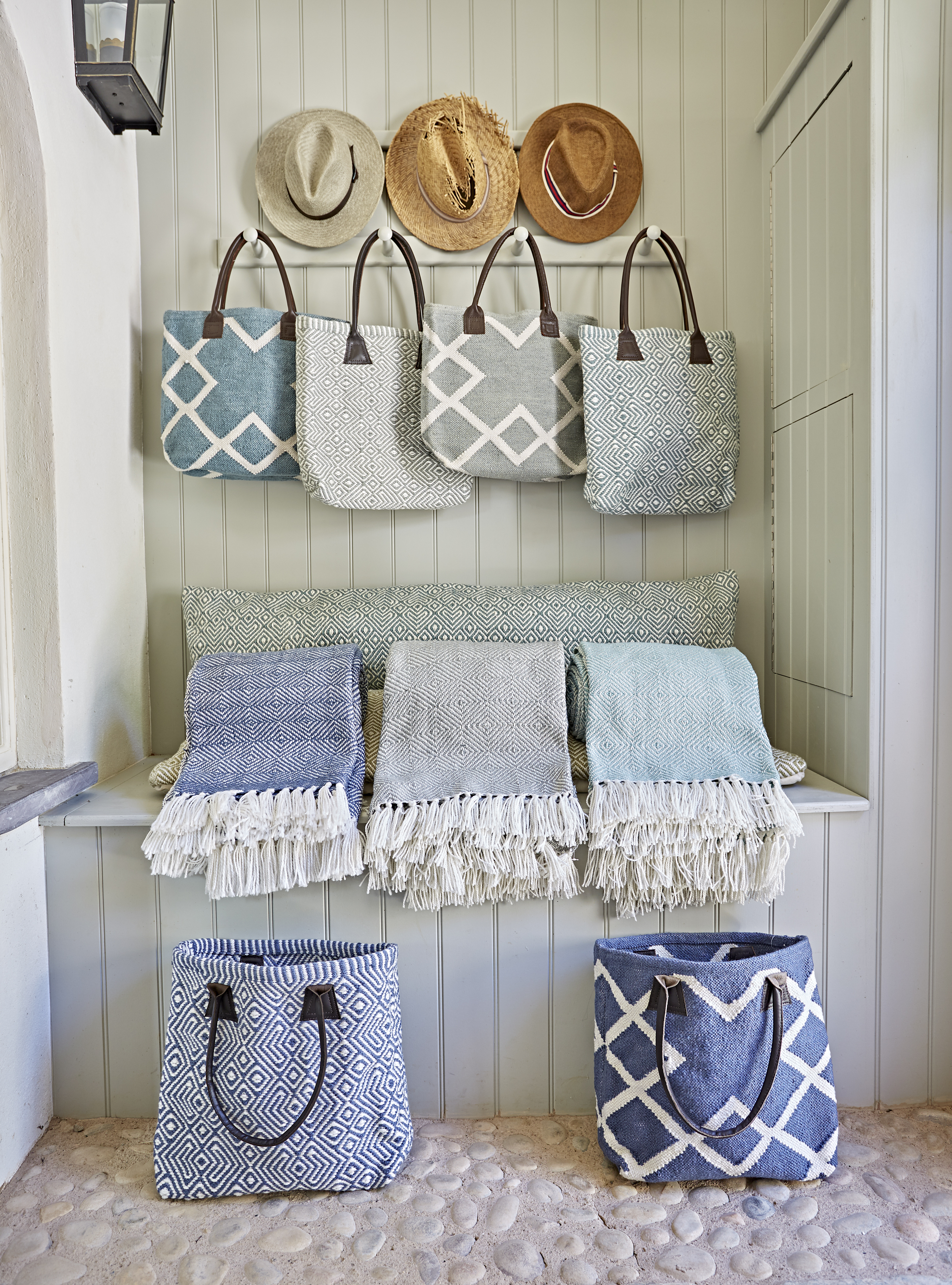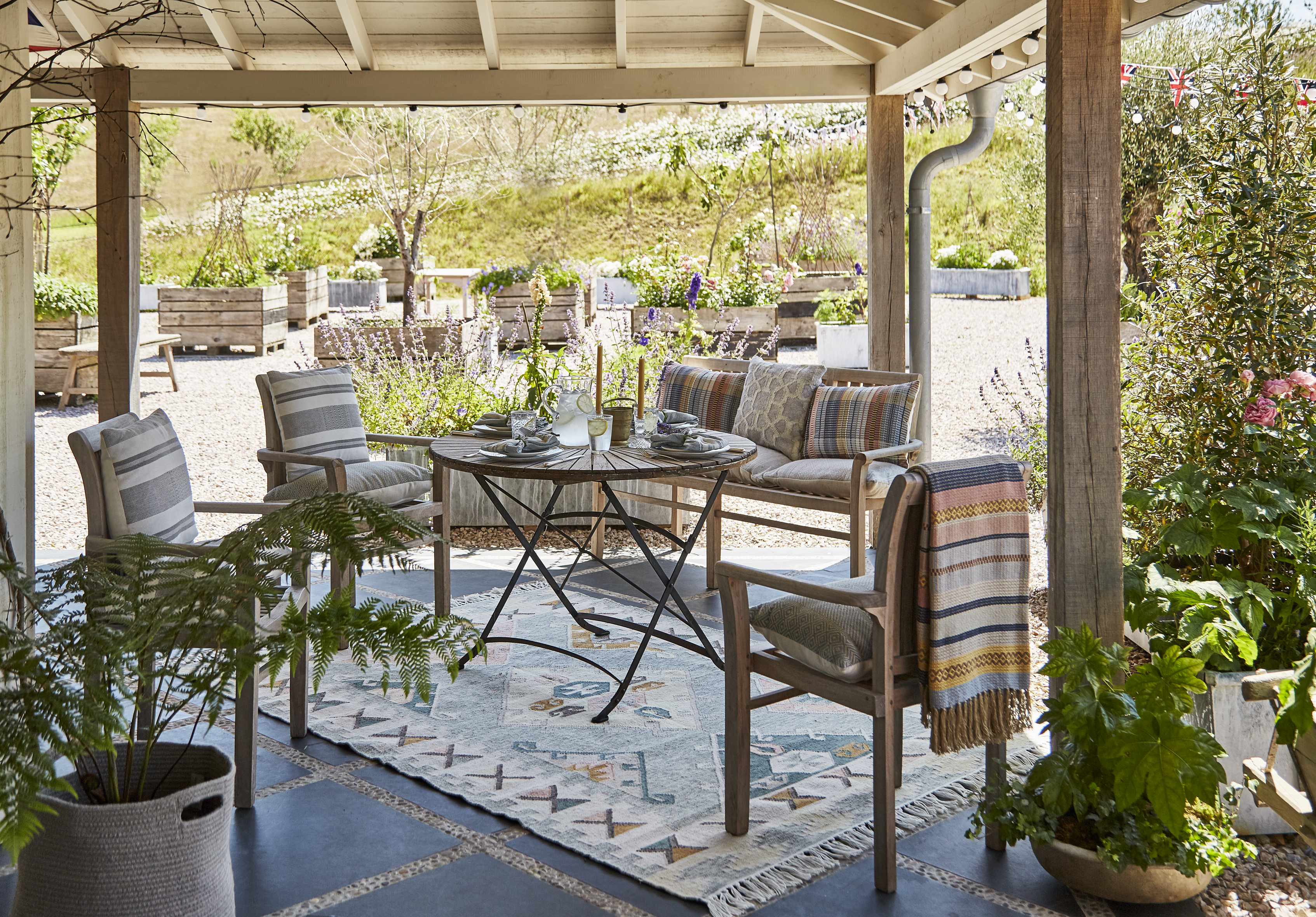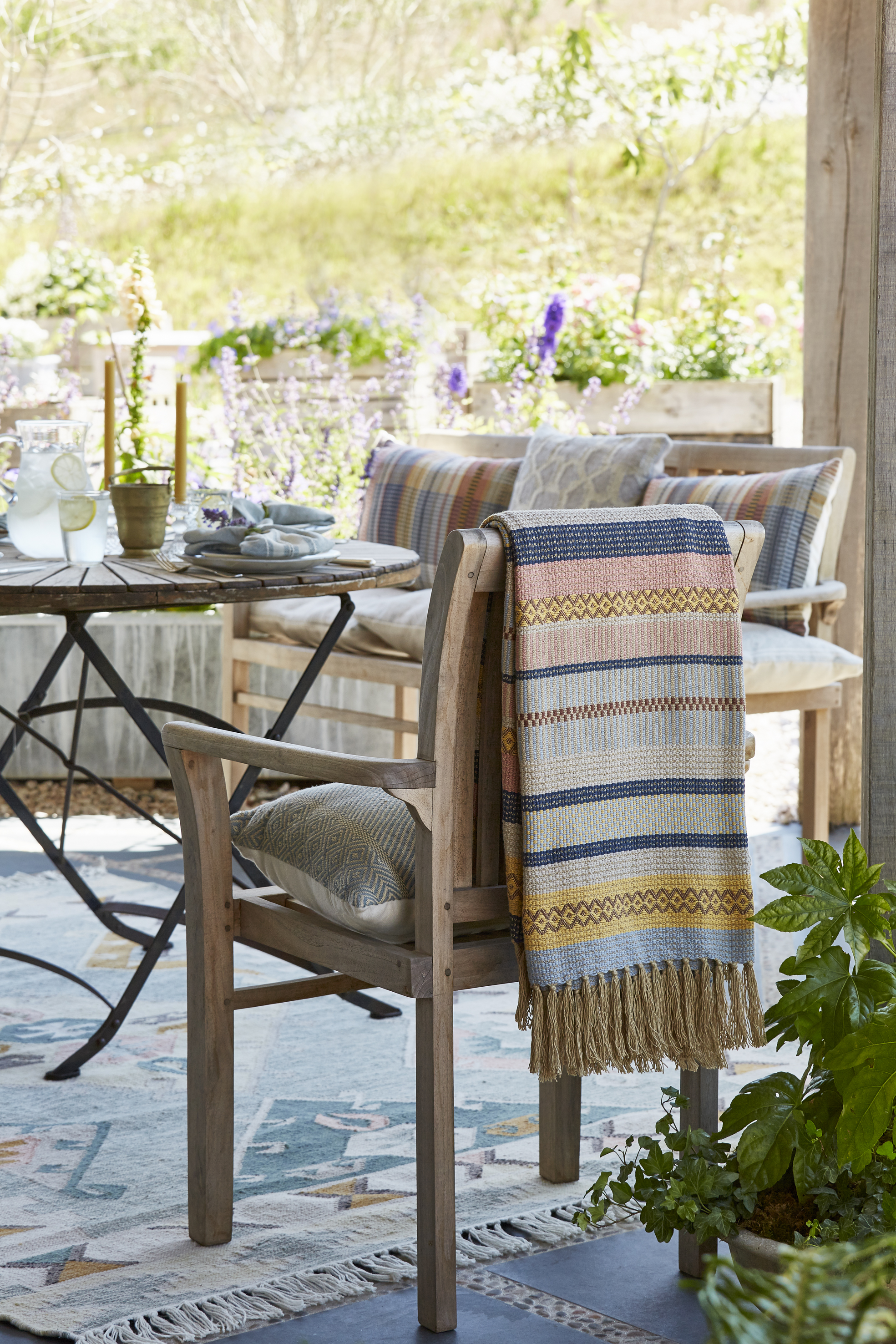Green Directory: Focus on Weaver Green
Greener textiles give more choice of sustainable products.
Discarded plastic bottles might seem like an unlikely starting point for soft furnishings. But Weaver Green’s indoor/outdoor rugs and cushions look and feel like fabric despite being made from old plastic bottles.

Image supplied by Weaver Green - Weaver Green Faro Sky Blue Rug
Set up by Tasha and Barney Green in 2015, the innovative company also uses recycled plastic to create handwoven blankets, bags, baskets and footstools that are available for sale online. The designs draw inspiration from all around the world from Scandinavia to Africa and Southern France, combining soft yellows, reds, blues and greys with natural tones.
The aim is to create beautiful soft furnishings that people want to use in their own homes with the added bonus they are good for the planet, too. “From the way we make our yarn to the materials we use for shipping we’re working hard to make our processes as eco-friendly as possible,” says the company.
All Weaver Green textiles are made from 100% recycled PET (Polyethylene terephthalate) plastic bottles. Each recycled rug is made from up to 3,000 salvaged plastic bottles, for instance. Over the last three years, the Devon-based company reckons it has recycled nearly 200 million plastic bottles that might otherwise have ended up in landfill or floating in oceans.
How it all started
“Tasha and I were In India where we got married and were inspired by the creativity and opportunity to make products there,” said flooring specialist Barney. The couple had previously made coir rugs. In India, they found fisherman making rope to tether their fishing boats from unravelled plastic bottles, that was both strong and waterproof. This proved to be a lightbulb moment. Could more of the world’s plastic waste be turned into useful and practical yarn?
Barney knows more than most about what’s involved in textile making due to his previous experience in the flooring industry. Meanwhile Tasha, who previously ran an organic drinks business, added her environmental awareness and design flair.
Recycling plastics into textiles isn’t a new concept. The biggest challenge, says Barney, was to create a soft yet durable material. After seven years of testing and work with manufacturers who had the technology, they produced a fibre deemed to have the soft feel of wool or cotton but with the practical, hardwearing, stain-resistant properties of plastic.
How is it made?
It starts with the bottles. Most plastic bottles used for soft drinks and water are made from polyethylene Terephthalate (PET), which is readily recyclable. Hard plastic containing PET is made of polymers, long chains of molecules, that can be broken down, recycled and re-spun into synthetic fabrics.
 Image supplied by Weaver Green - Weaver Green Tote Bags
Image supplied by Weaver Green - Weaver Green Tote Bags
The first step is to collect the bottles on beaches and coastal regions in places like northern India and then to sort them based on material type. Plastic bottles must be separated from non-PET contaminants, such as polypropylene lids. The sorted bottles are then mechanically shredded into very fine ribbons. The ribbons are then heated, stretched and spun into yarn. Finally, the dyed yarn is hand loomed by artisan into textiles using traditional weaving techniques.
By the end of 2019, Weaver Green reckons it had recycled its 100 millionth plastic bottle. “Almost half of them have been retrieved from streams, rivers and the coast while the rest were chucked away after the briefest of purposeful life, especially given the 450 years it takes an average plastic bottle to break down,” says the company.
Eco-credentials
Among the main benefits of using recycled plastic bottles to make textiles is that it helps to reduce waste and conserve natural resources. According to Weaver Green, making yarn from recycled plastic bottles uses as much as 70% less energy and nearly 90% less water compared to producing polyester textiles from virgin materials. Recycling plastic conserves precious resources that go into making the plastic bottles in the first place, like crude oil and water.
Weaver Green says all its rugs and textiles have the same soft feel of wool or cotton, but thanks to being made from recycled plastic, the textiles are durable, moth proof, easy to wipe clean, mould-resistant, UV stable and hard-wearing. This makes them well suited for kitchens, hallways, bathrooms, garden terraces and even picnics on the beach.
 Image supplied by Weaver Green - Weaver Green Andalucia Granada Rug
Image supplied by Weaver Green - Weaver Green Andalucia Granada Rug
The factory in India that produces yarn for Weaver Green uses a closed water system, says Barney. This means all products are washed and dyed with the same re-filtered water rather than using new water supplies and releasing unfiltered water into the sewerage system.
In addition to using non-toxic dyes, the dye vats are heated by burning discarded rice and wheat husks, a by-product of local cereal production, in low emission boilers. All these measures help to minimise pollution from production and reduce reliance on fossil fuels, says Weaver Green.
Tackling microfibres
Recycling plastic bottles into textiles gets points for sustainability, giving plastics a second life, but there is a downside. Recycled polyester decomposes and breaks into microplastics easier and faster than virgin fabrics.
Microfibres are plastic nano-fibres that break off from textiles through wear and tear, especially in the washing machine. These microplastics get into waterways and oceans and are ingested by aquatic organisms, entering the food chain. We ingest the equivalent of one credit card of plastic a week through our food and water, according to a WWF analysis.
Weaver Green addresses the microplastics issue on its website. “In 2018, 40% of the plastic bottles we used were retrieved from rivers and waterways which were destined for the ocean. It’s important to us that the plastic we retrieve doesn’t end up in the sea in any form, so we’re constantly working on ways to limit microfibre shedding.”
The company uses long strand yarn to improve tensile strength and reduce the risk of microfibre shedding. Unlike clothing made from recycled plastic bottles, soft furnishings rarely need to be washed. “Although our textiles are machine washable, realistically they should only need that kind of deep clean on rare occasions. When they are washed, we always recommend short, cold cycles with full loads and no spin dry; doing so will help to minimise the shedding of microfibres.”
 Image supplied by Weaver Green - Weaver Green Darjeeling Heather Throw
Image supplied by Weaver Green - Weaver Green Darjeeling Heather Throw
Social impact
The social impact of green products is important, too. According to Weaver Green, the company only uses weaving houses committed to employing skilled adults, who are paid fairly and enjoy comfortable working conditions. These artisan weavers are mostly based in India and Turkey.
While the company doesn’t currently have any independent green product certifications or eco-labels, such as FairTrade or WaterSense, this is something they are working on, said a spokesman
